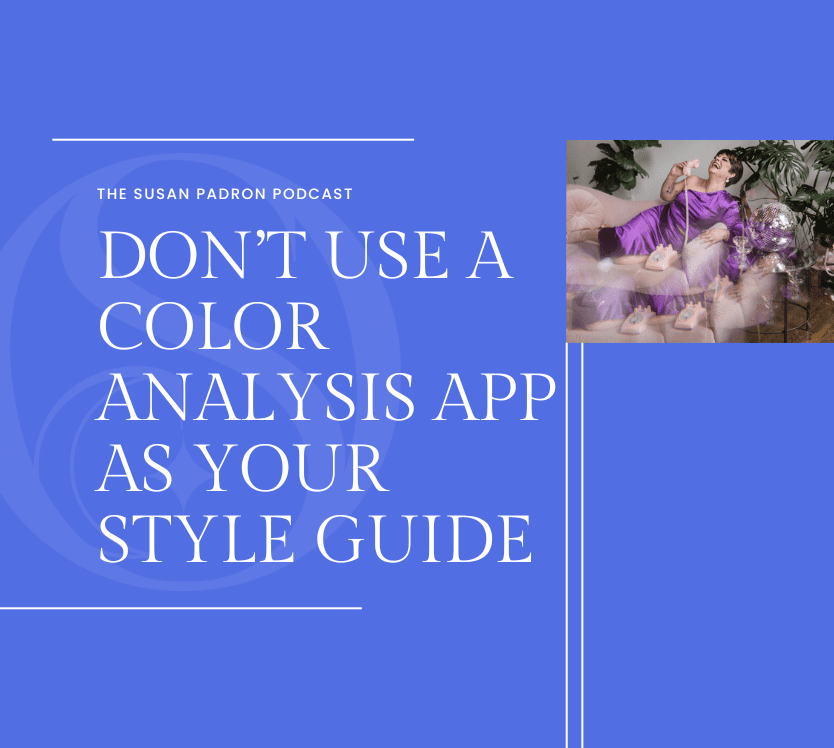“Have you tried to do a color analysis on yourself? Do you just end up feeling more confused after trying color analysis filters or apps? That’s totally normal. The filters and apps almost always get your color analysis wrong, and there are a few reasons for that.”
As a society, we’re becoming more and more driven by technology and instant solutions. Apps and filters that claim to help you figure out your seasonal color palette are trending on Instagram and TikTok, attracting people who want to understand their best colors for clothing and makeup. These tools promise quick, convenient results without leaving your home or spending money. Just turn the color-matching mode on, and voilà!
The allure of color analysis apps is strong, but they often fail to deliver accurate and personalized color analysis. There are several reasons for that, and I’m discussing why you should work with a fashion color stylist vs. a smart color picker in this podcast episode!
In This Episode, We Talked About Why You Shouldn’t Use Color Analysis Apps and Filters
First things first, what is the seasonal color analysis theory?
You can use this method to determine the colors that best complement your natural features by categorizing them into one of four seasonal palettes: Winter, Spring, Summer, or Autumn.
According to the seasonal color analysis approach, each season is characterized by distinct color qualities. Winter and Summer are cool-toned, but Winter favors high contrast and vibrant shades, while Summer leans towards softer, muted hues. Spring and Autumn are focused on warm colors, with Spring embracing bright, clear colors and Autumn preferring rich, earthy tones.
You need to account for skin undertones, hair, and eye color to create a cohesive and flattering custom palette that enhances your natural beauty and harmonizes your appearance. Color analysis apps claim to do this, but the generated app colors are often wrong…Why? Let’s unpack this!
Why Color Analysis Apps Get It Wrong
The Lighting
One of the most critical factors in color analysis is lighting. Different lighting conditions—such as harsh fluorescent lights and varying quality of daylight—can drastically alter the appearance of your skin tone and the perceived color of your clothing and makeup.
Natural daylight is the ideal environment for assessing colors because it allows for the most accurate representation of your hues. However, color analysis apps rarely account for the differences in lighting conditions when you take your photo. Smart color picker simply does your personal color analysis without considering the lighting.
Wearing Makeup
If a smart color picker analyzes your face while wearing makeup, you won’t get accurate results, especially if the makeup is not perfectly suited to your natural coloring. Many people unknowingly wear makeup shades that do not enhance their natural skin tone, which can lead to a distorted analysis. For example, a foundation that is too light or too dark can change the perceived undertone of your skin.
Natural Color Biases
You’re human and have natural color biases that can impact your judgment when using a self-color analysis application. You probably have certain color palettes you like and others you don’t like. You’re also probably used to seeing yourself in a certain way and are attached to certain palette colors. You may feel disappointed and confused when an app recommends a different color spectrum. If this happens, you won’t know how to apply the recommendation you received to improve your style.
The Limitations of Your Color Palette App
If you’re using a color app, you should know it has many limitations. These apps lack personalization and rely on algorithms that generalize factors such as skin tone, undertones, eye color, hair colors, and personal style. There’s an absence of a human touch and nuance in color-matching mode searches.
The Benefits of Working with a Certified Color Analyst
Working with a certified color analyst helps you figure out what colors to wear—and how to wear them—to complement your natural features and boost your confidence. Instead of a generic approach, your color analyst will physically assess the best color spectrums for your unique appearance so you can amplify your spirit, not diminish it.
A color analyst doesn’t only focus on colors, either. In my work, I strive for harmony and balance. I don’t want the colors you wear to detract from YOU, even if a particular piece of clothing looks good. I want your outfits to enhance your natural beauty so that YOU are the star of the show, not the color you wear.
The Emotional Impact of Knowing Your Seasonal Color Analysis
The emotional impact of knowing your color palette and how to use it extends beyond the aesthetics. It influences your mood and self-expression.
A clear understanding of your color palette helps streamline your wardrobe, making it easier to mix and match pieces. This simplifies getting dressed and ensures that you always feel confident, strong, and sexy. When done right, color analysis allows you to express your personality and style authentically, creating a deeper connection with yourself and others!
Hear Why You Shouldn’t Use a Color Analysis App as Your Style Guide in This Episode of the Susan Padron Podcast
Check out the Susan Padron Podcast on Apple Podcasts or Spotify. While you’re there, hit subscribe!
What’s Next?
If you’re ready to create magic, I offer online and in-person color analysis sessions so you can stop putting up with looking “just okay.” Instead, you’ll walk away with a solid understanding of what colors make you shine and how to incorporate them into different seasons of life so you can step into your era of authentic self-expression. Learn more about the color analysis sessions!
You can also get more information and outfit ideas on my socials:
